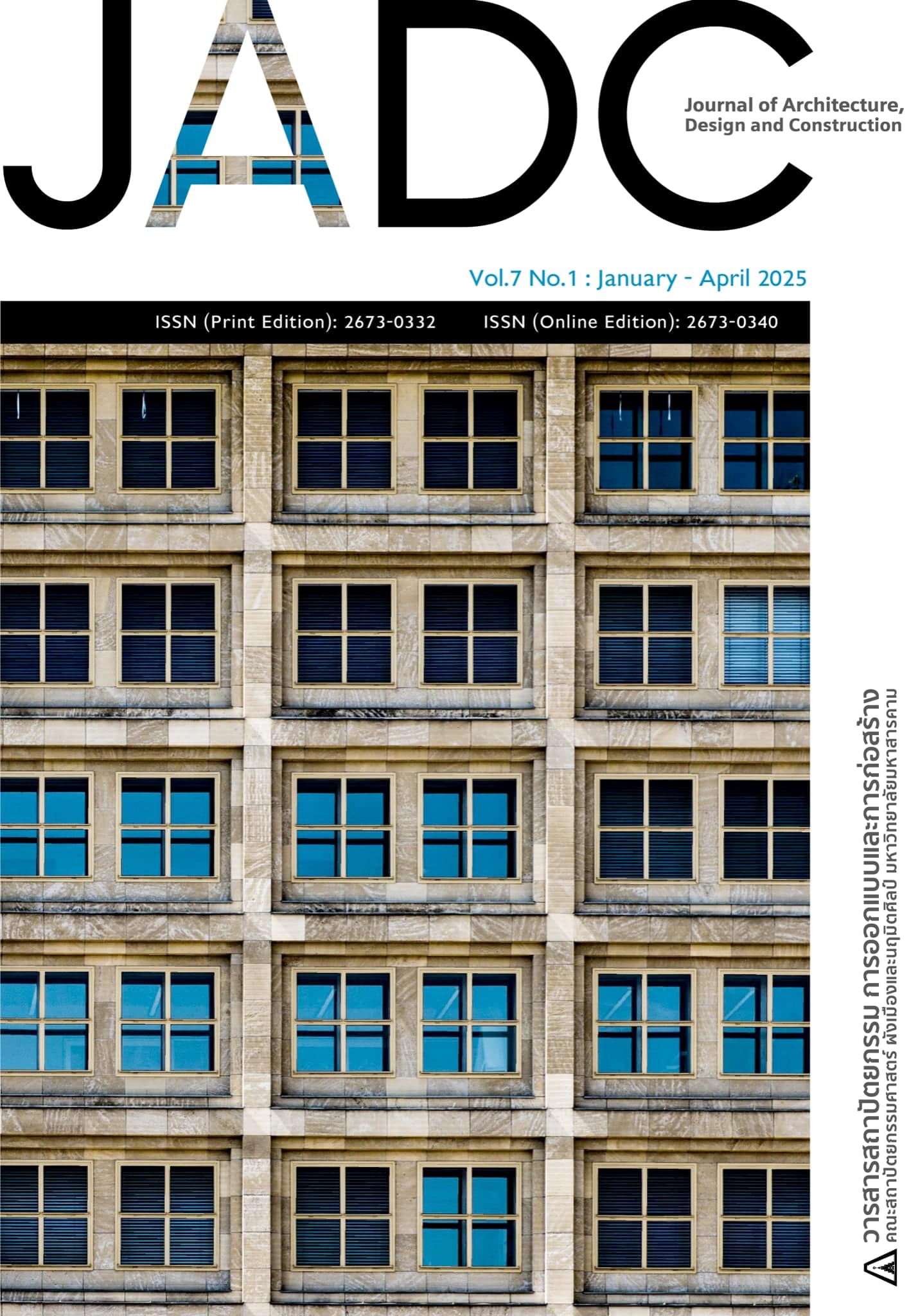The Study of Changes in Urban Information Data to Enforce According to the Town Plan, Tha Khong, Khlong Luang, Rangsit, Pathum Thani Province
Main Article Content
Abstract
The objective of this research is to examine the urban planning process and gather urban information to propose techniques for utilizing urban information tools as a guideline for urban planning in Tha Khong Municipality, Khlong Luang Municipality, and Rangsit City Municipality in Pathum Thani Province. This study involves analyzing related concepts and theories to guide the selection of information tools used for physical analysis by comparing land use plans to identify the impact of changes. The study includes specific interviews conducted in the field with relevant agencies or experts involved in the urban planning process. Given that certain land uses in these areas have deviated from regulations and that the Urban Planning Act of 2019 has undergone changes, the study proposes techniques and tools as guidelines for urban planning. The research findings, derived from interviews, indicate that the most crucial plan in the urban planning process is the land use plan, followed by telecommunications and water plans. These plans are essential for decision-making in planning, data collection, verification, and correction, and they are applied in physical analysis. The study found that between 2008 and 2019, residential land use underwent the most significant change, accounting for 75% of the area, followed by industrial land use, due to the expansion of the industrial sector and population growth, leading to urban expansion and increased density. The researcher calculated and determined the FAR (Floor Area Ratio), BCR (Building Coverage Ratio), and OSR (Open Space Ratio) for the three municipal areas within each land use block to utilize tools for developing and analyzing impacts in three areas: physical, economic, and social, which directly affect the quality of life and city image. The research suggests the use of the urban information tool, SuperMap 10i, which assists in managing large datasets across various agencies with convenience and speed. It facilitates the collection of data in a Data Center on a Cloud Server with advanced security systems and presents results in the form of a Dashboard on WebBrowser or Mobile, making it easier to display results and serve as a guideline for more effective urban planning.
Downloads
Article Details

This work is licensed under a Creative Commons Attribution-NonCommercial-NoDerivatives 4.0 International License.
The articles published in the Journal of Architecture, Design, and Construction are the intellectual property of the Faculty of Architecture, Urban Planning, and Fine Arts, Mahasarakham University.
References
กรมชลประทาน. (2563, 10 กุมภาพันธ์). ความหมายของระบบสารสนเทศภูมิศาสตร์ GIS. http://kmcenter.rid.go.th/kcitc/2011/index.php?option=com_content&view=article&id=196:2009-09-3009-27-16&catid=47:2011-08-25-08-18-13
พระราชบัญญัติการผังเมือง 2562. (2562, 29 พฤษภาคม). ราชกิจจานุเบกษา. เล่ม 136 ตอนที่ 71 ก หน้า 27-70.
กรมโยธาธิการและผังเมือง. (2562, 8 กุมภาพันธ์). พระราชบัญญัติการผังเมือง 2562. http://subsites.dpt.go.th/edocument/index.php/docurban/1-2017-04-03-02-20-29
กัญญารัตน์ ศรีธินนท์. (2558). การพัฒนาเครื่องมือ FAR Bonus ในการเพิ่มที่โล่งเพื่อประโยชน์สาธารณะตามผังเมืองรวม กรุงเทพมหานคร [วิทยานิพนธ์ปริญญามหาบัณฑิต, มหาวิทยาลัยเกษตรศาสตร์]. KU E-thesis. https://intanin.lib.ku.ac.th/search?/a{u0E01}{u0E31}{u0E0D}{u0E0D}{u0E32}{u0E23}{u0E31}{u0E15}{u0E19}{u0E4C}+/a|a1d1adadd2c3d1b5b9ec/1%2C41%2C101%2CB/frameset&FF=a|a1d1adadd2c3d1b5b9ec+c8c3d5b8d4b9b9b7ec&1%2C1%2C
จักรพงษ์ มาพร. (2558). วิธีการกำหนดอัตราส่วนพื้นที่อาคารรวมต่อพื้นที่ดินในพื้นที่ประวัติศาสตร์ของเมือง: กรณีศึกษาพื้นที่โดยรอบสถานีรถไฟฟ้าใต้ดินวัดมังกร [วิทยานิพนธ์ปริญญามหาบัณฑิต, มหาวิทยาลัยศิลปากร]. DSpace JSPUI. http://ithesisir.su.ac.th/dspace/handle/123456789/706
พิเศษ เสนาวงษ์. (2564). การพัฒนาระบบสนับสนุนการตัดสินใจในการวางแผนการใช้ที่ดินอย่างยั่งยืนเพื่อการขับเคลื่อนตามแนวทางของยุทธศาสตร์ชาติ. วารสารมนุษยศาสตร์และสังคมศาสตร์ปริทัศน์ มหาวิทยาลัยราชภัฏลำปาง, 8(1), 16–31. http://www.human.lpru.ac.th/husocojs/index.php/HUSOCReview/article/viewFile/174/120
มานะ สินธุวงษานนท์, ณัฐยา บุญกองแสน และ กชกร หวังเติมกลาง. (2566). การศึกษากับเป้าหมายการพัฒนาที่ยั่งยืน (SDGs). วารสารมณีเชษฐาราม วัดจอมมณี, 5(6), 527–544. https://so07.tci-thaijo.org/index.php/JMCR/article/view/3355
ศิริวัฒน์ เจนรังสรรค์ และ วิมลสิริ แสงกรด. (2562). การพัฒนาเทศบาลเมืองให้เป็นเมืองอัจฉริยะในพื้นที่จังหวัดขอนแก่น. Journal of Buddhist Education and Research, 5(2), 361–375. https://so06.tci-thaijo.org/index.php/jber/issue/view/16630
ศูนย์วิจัยภูมิศาสตร์เพื่อประเทศไทย. (2562, 21 มกราคม). องค์ประกอบของระบบสารสนเทศภูมิศาสตร์. http://www.gisthai.org/about-gis/compo-gis.html
สำนักงานเทศบาลนครรังสิต. (2562, 22 มกราคม). โครงการจ้างที่ปรึกษาวางและปรับปรุงผังเมืองรวมเมืองท่าโขลง-คลองหลวง-รังสิต จังหวัดปทุมธานี. https://www.dla.go.th/upload/news/type3/2018/7/39311_3.pdf?time=1532553298924
Anthopoulos, L. G. (2015). Understanding the smart city domain: A literature review. In Transforming city governments for successful smart cities. (pp. 9–21). Springer. https://doi.org/10.1007/978-3-319-03167-5_2
Dantas, H. S., Sousa, J. M. M. S., & Melo, H. C. (2019). The importance of city information modeling (CIM) for cities’ sustainability. In IOP conference series: Earth and environmental science, 225(1). https://doi.org/10.1088/1755-1315/225/1/012074
Xu, X., Ding, L., Luo, H., & Ma, L. (2014). From building information modeling to city information modeling. Journal of Information Technology in Construction, 19, 292–307. https://www.itcon.org/paper/2014/17

